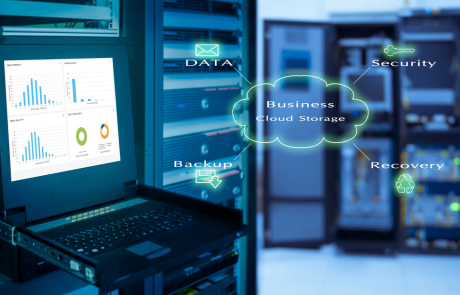AWS Cloud Monitoring: Best Practices and Tools
It can’t be denied that migrating your business’ operations to cloud provides you with unparalleled benefits. From cost reduction to elimination of hardware maintenance – the Cloud has it all. Fortunately, Amazon Web Services just happens to be the cloud provider that can offer it all: reliable services, reasonable prices, and trustworthy partners. Thinking about migrating your company’s infrastructure to cloud? Contact Romexsoft, AWS Consulting Partner with more than 15 years experience, and our experts will consult you on the matter.
Table of Contents
Why Cloud Monitoring is Important
In spite of all the numerous benefits that “cloud” can provide, it still needs to be regularly assessed and frequently maintained. You see, hosting your business operations in the cloud is a constant process of trial-and-error. Whatever the amount of research and preparation you do, some things will still need to be tweaked and re-adjusted. Without proper maintenance, cloud infrastructures may become unnecessarily big, noticeably slow, and unpleasantly expensive. Fear not, because AWS provides its users with an abundance of invaluable tools for cloud monitoring. If done properly, cloud monitoring can show how to improve speed of operations, reduce your end-of-month bill, and predict and prevent any unpleasant events from occurring.
In this article, our AWS Cloud Monitoring experts have outlined five of the best practices and tools of cloud infrastructure monitoring.
1. Automate your tasks
We live in an era of automation. Nowadays, mundane tasks require less and less human assistance. This principle can be easily applied to monitoring your cloud infrastructure. Plan and schedule responses to specific tasks to ease the workload on your infrastructures.

AWS Lambda
AWS Lambda is a tool that can execute tasks in response to AWS events. There are a number of AWS services that can be connected to Lambda. Such services send out API requests that Lambda can process and respond to. AWS Lambda is like a breath of fresh air compared to more traditional AWS monitoring services.
2. Scale infrastructure on demand
When you deploy and operate your instances, you’ll need to make sure that you monitor them to ensure your infrastructure is working properly. The performance of your instances can show whether there are any failures in your processes. The amount of usage you get from your instances can show if some of them are underutilized or over-worked. This data provides valuable insight into your operations and helps make decisions about scaling either up or down according to demand.

Amazon EC2
Elastic Compute Cloud is an Amazon service that provides scalable computing capacity. EC2 instances come with a range of metrics that are easy to monitor and interpret into important data points. To get the most out of your EC2 instances and their resize ability, you will need to understand their availability and performance, track CPU utilization and the amount of data that is being read/written, and more.
3. Monitor the amount of Traffic
The user experience of your applications greatly depends on how fast they perform. Users are bound to notice that there is something wrong with an application if it’s taking too long to respond. This is why tracking the amount of traffic that goes through your applications.

Amazon ELB
Elastic Load Balancing handles traffic by means of distributing it across multiple targets (for instance, your EC2 volumes). It provides great insight into the performance and health of your apps’ traffic by means of multiple indicators. You can greatly improve the user experience of your applications if you track your key ELB metrics and take proper measures to address any issues.
4. Watch your Storage Capacity
When hosting in the cloud, you absolutely need to make sure that there is enough storage to accommodate all your application’s needs. In addition to that, you need to know exactly how the amount of storage you reserved correlates with the amount of storage your app actually uses. It’s important both for your infrastructure performance and cost optimization.
Amazon EBS
Elastic Block Storage provides block level storage volumes to accommodate your EC2 instances. Amazon EBS has proven to be a reliable, long-term storage solution for EC2 instances. Being extremely convenient, EBS provides its users with data on volume performance and amount of usage the volumes get. These metrics are vital in analyzing and optimizing your storage to ensure smooth performance of your infrastructures.
5. Don’t forget about Cache
If you have read-intensive workloads, you may want to look at ways to implement caching into your infrastructure. Cache allows quick access to frequently used data without requesting it from the backend. Caching improves the speed of your applications, thus providing better user experience.
Amazon ElastiCache
ElastiCache is a service that provides in-memory cache environments for AWS cloud. With ElastiCache you can choose one of two caching engines, Redis or Memcached. ElastiCache provides a number of metrics to monitor, such as the number of users connected to the cache, that help determine efficiency and overall “health” of your caching environment.
Read more about AWS services.
Wrapping Up
Maintaining your cloud infrastructure is important. The more in-depth you get with your cloud analysis, the better business decisions you can make. Keeping track of all the vital metrics can make it or break it in receiving valuable business insights that later can impact your revenues, savings and overall operation efficiency.
To get the most out of your AWS Cloud experience, make sure to use all AWS Cloud monitoring tools there are. All of them can be easily integrated with your current cloud systems and are straightforward in their operation and maintenance.
Here at Romexsoft, we are all about efficiency. Want to know how to optimise your existing cloud infrastructure and reduce your end-of-month bill? Contact our experts – cloud professionals with more that a decade of experience – to get a consultation.
